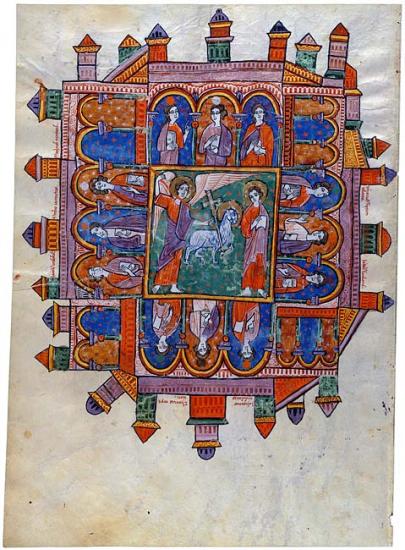
Las Huelgas Apocalypse
Spain
1220
Then I saw a new heaven and a new earth, for the first heaven and the first earth had passed away, and the sea was no more. I saw the holy city, new Jerusalem, coming down out of heaven from God, made ready like a bride adorned for her husband. (Apocalypse 20:1-2)
St. John has seen Hell and Satan bound with Death. Now he sees a new world emerge, clean and free of all stain. It is all that Isaiah hoped for: “Behold, I create new heavens and new earth” (Is. 65:17 and 66:2). It is everything that Enoch described: “The first heaven shall depart and pass away; a new heaven shall appear” (1 Enoch 91:16).
Some say that “there was no more sea” because the sea is the primaeval abyss, the chaos out of which matter emerged and there is no more chaos when judgement is complete. Some readers point out that seven markers of the fallen world are “no more” in the concluding chapters of the Apocalypse: the sea, death, mourning, crying, pain, every accursed thing, night. In the City of God, St. Augustine favors the idea that “the sea” is a euphemism for Death–cold, dark, deep, where a crowd can still be a vast collection of individuals in isolation. It is this Death that is no more in the new world adorned like a bride for her bridegroom and so the sea is “no more.”
In the Old Testament, the city Jerusalem is both a mourning virgin and a glorious bride. Now the time of her mourning has passed and her final victory and beauty are revealed. The bride of the Song of Songs takes her place alongside her heavenly bridegroom; during the Middle Ages, most sermons about the Song were also sermons about the Apocalypse and most sermons about the APocalypse were also sermons about the Song. The two texts go hand-in-hand. The Old Testament dreams of her glory and her dazzling garments are commonly read in church at Epiphany and Holy Saturday: the two days that most clearly anticipate the coming End and ultimate triumph of God.
Epiphany (the revelation of God’s glory in the darkness, the baptism of Christ when he descends into the water to slay the dragons hidden there as a dress rehearsal of his Passion) and Holy Saturday (Christ’s descent into the dark land of the dead–the sea mentioned earlier–to shatter the darkness with light and break the chains of those in prison there) are reflections in time of the eternal reality that is now revealed at the conclusion of the Apocalypse.
Epiphany. Holy Saturday. The conclusion of the Apocalypse. Jerusalem is adorned like a bride for her groom, the old context and environment of death and sin being swept away as the new context and environment of God’s glory is hidden no longer but emerges clearly for all to see.
